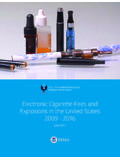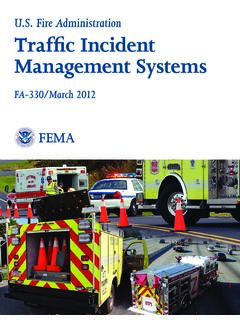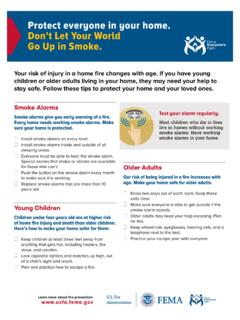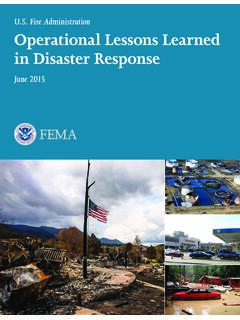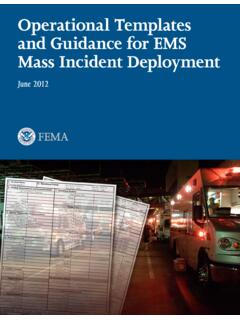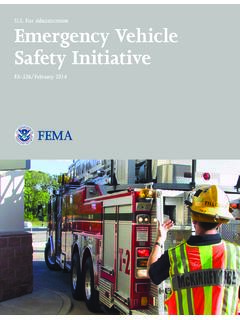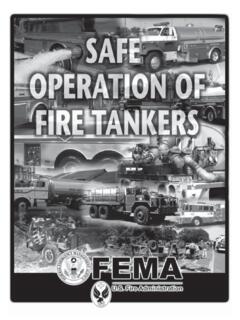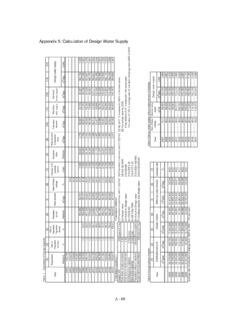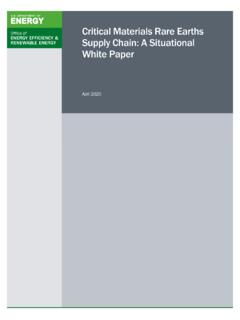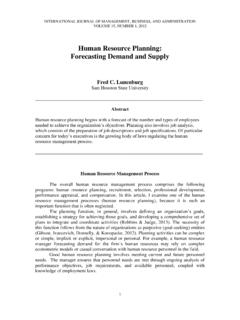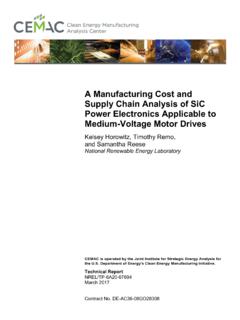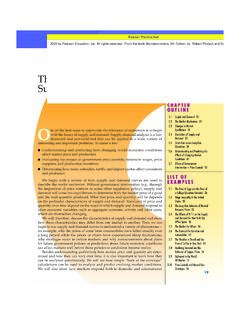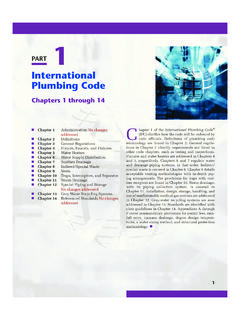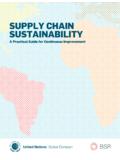Transcription of Water Supply Systems and Evaluation Methods: Volume I
1 Fire AdministrationWater Supply Systems and Evaluation MethodsVolume I: Water Supply System ConceptsOctober Fire AdministrationMission StatementWe provide National leadership to foster a solid foundation for local fire and emergency services for prevention, preparedness and Supply Systems and Evaluation Methods Volume I: Water Supply System Concepts Harry E. Hickey, project was performed by the Society of Fire Protection Engineers (SFPE) and was supported by the Department of Homeland Security s Science and Technology Directorate and the Fire Administration (USFA). SFPE is an engineering association for advancing the science and practice of fire protection engineering. Water Supply is an important subject to the fire service, fire protection engineers, and city managers. These manuals are intended to provide a reference for concepts and terminology to facilitate communication and understanding between these the AuthorDr.
2 Harry E. Hickey s career in fire protection spans more than 50 years. He taught Fire Protection Engineering at the University of Maryland for 26 years. He also has extensive experience in the fire services both as a firefighter, fire officer and Emergency Coordinator. His combination of municipal fire administration and fire protection engineering experience provides him with unique insight into the challenges of design and operation of municipal Water supplies. He received his in Public Administration from American University in Washington, DC. He has authored many book and articles including Public Fire Safety, A Systems Approach, Fire Protection Hydraulics, and two editions of The Fire Suppression Rating Schedule Handbook. v Table of ContentsChapter 1: Fundamental Considerations Topic 1: Anatomy of a Water System ..6 Topic 2: Continuous Availability of Water Supply ..11 Topic 3: Municipal Water Supply Considerations.
3 13 Topic 4: Water Sources ..16 Topic 5: Classification of Water Systems ..19 Chapter 2: Processed Water for Domestic Consumption ..20 Topic 1: Unfiltered Surface Water Sources ..20 Topic 2: Filtered Surface Water Sources ..21 Topic 3: Water Treatment Plants ..23 Topic 4: Auxiliary Facilities for Surface Water Treatment ..28 Topic 5: Ground Subsurface Water Systems ..29 Chapter 3: Water Quality Standards ..32 A General Perspective on Water Quality ..32 Water Quality Monitoring ..39 Chapter 4: Water Distribution System Design Concepts ..51 Water Supply Source Classifications ..51 Water System Components ..52 Water System Classifications ..52 Composite Water Supply Systems ..56 System Demand, Water Design and Flow Criteria ..57 Rates of Water Use ..58 Distribution System Hydrant Locations ..66 System Evaluation and Design ..71 vi Wa t e r Su p p l y Sy S t e mS Vo l. I: Sy S t e m Co nC e p tS ta b l e o f Co n t e n tS Basic Concepts in Determining Design Flow at System Demand Points.
4 73 Distribution System Storage ..75 Elevated and Ground Storage ..77 Comparison of System Examples ..84 Recommended Practice on Water Storage ..84 Chapter 5: Consumer Consumption and Needed Fire Flow ..86 Water Demands ..86 A Suitable Approach for Studying Consumer Use Water Demand ..91 Fire Suppression Water Demand ..91 Special Notes on the Determination of Needed Fire Flows ..99 Chapter 6: Alternative Water Supplies ..101 Alternative Water Supply Concepts ..103 Where are Alternative Water Supplies Needed ..104 Water Supply Officer ..104 Identifying and Certifying Alternative Water Supplies ..105 Establishing an Alternative Water Delivery Program ..112 Chapter 7: Impacts of Fire Flow on Distribution System Water Quality, Design and Operation ..117 Background Statement ..117 Background ..118 Study Objectives and Scope ..118 Chapter 8: Dual Water Systems ..138 Basic Concepts ..138 Background Information ..139 Potential Applications for Dual Distribution Systems .
5 139 Sources of Nonpotable Water ..141 Potential Uses of Nonpotable Water ..141 Potential Uses for Nonpotable Water ..141 Nonpotable Water Reuse Legislation ..143 Reclaimed Water Quality and Treatment Requirements ..145 Reclaimed Water Monitoring Requirements ..146 Treatment Facility Reliability ..147 Groundwater Monitoring ..147 vii Wa t e r Su p p l y Sy S t e mS Vo l. I: Sy S t e m Co nC e p tS ta b l e o f Co n t e n tS Treatment for Reclaimed Water ..148 Reclamation Plants ..149 Storage ..150 Features of Reclaimed Water Distribution Systems ..151 The Future Role of Dual Water Systems ..152 Chapter 9: Water Supply and Effective Fire Protection ..153 Overview ..153 The Insurance Services Office, The Ability of Fire Departments to Provide Effective Fire Protection ..154 Fire Insurance Rates ..155 An Overview of Water Supply Under the ISO Fire Suppression Rating Schedule ..155 Insurance Company Assistance on Evaluating Water Supplies.
6 158 Advantages of Automatic Sprinkler Systems ..159 Water Supply Requirements for Sprinklered Properties ..161 Design Curves ..161 Hazard Classifications ..163 Residential Sprinkler Systems ..163 Types of Sprinklers for Commercial Buildings ..164 Pipe Schedule Systems ..164 Hydraulically Calculated Systems ..164 Standpipes ..165 The Physical Properties of Water ..168 Water Mist Fire Protection Systems ..171 Class A Foam Fire Protection ..174 Chapter 10: Separate Water Systems and Emergency Water Supplies ..178 Part I ..178 A Current Need for Individual Water Systems for Fire Protection ..180 Basic Design Concepts for Individual Water Supplies for Fire Protection ..181 Part II: Emergency Water Supplies ..184 1 W ater for human consumption comes from one of two basic sources: 1) Water from a well to Supply an individual residence, well Water for farmstead properties, and well Water for small public sector properties that include schools, public buildings, and small commercial ) Municipal Water Systems that provide potable Water to a wide array of commercial property and domestic use buildings including apartments, condominiums, duplex housing, and single family dwellings.
7 This chapter uses the Washington, DC, Water System as an example in order to introduce concepts associated with a fundamental understanding of Water distribution Systems . This system was selected because it typifies many of the Water Systems in the United States that rely on Water sources including rivers, lakes, and low-level Water retention dams. Other Water Supply sources are examined under Topic 3 in this the fundamentals of a municipal Water Supply delivery system is essential to closely examining the many features of a Water system and the many options in designing a Water delivery system. Chapter 1 provides a basic overview of: The Anatomy of a Water System The Need for a Continuously Available Water Supply Considerations for Establishing Municipal Water Supply Systems Classification of Water Supply Sources The Classification of Water Supply SystemsTo p i c 1: Anatomy of a Water SystemThe purpose of municipal Water delivery Systems is to transport potable Water from a Water treatment facility to residential consumers, for use as drinking Water , Water for cooking, Water for sanitary conditions, and other Water use in a domestic environment.
8 Water Supply also is essential for business and industry to operate in a municipal environment. Of no less importance is the need to Supply Water to properly located fire hydrants to provide the public with an effective level of fire protection. Municipal Water Systems also may need to provide Water for special services that include street cleaning, the selling of Water to contractors for erecting buildings, parks and recreation, and miscellaneous a pT e r 1: Fundamental Considerations 2 Wa t e r Su p p l y Sy S t e mS Vo l. I: Sy S t e m Co nC e p tS Ch a p t e r 1: fu n d a m e n t a l Co nS I d e r a tI o nSA Water system has two primary requirements: First, it needs to deliver adequate amounts of Water to meet consumer consumption requirements plus needed fire flow requirements. Second, the Water system needs to be reliable; the required amount of Water needs to be available 24 hours a day, 365 days a year. Anatomy may be defined as separating or dividing a function into parts for detailed examination.
9 (1) A Water Supply system is analogous to the human circulatory system. The heart pumps blood through the arteries, veins, and capillaries to Supply oxygen to all part of the body. A Water pump supplies Water through primary, secondary, and distributor Water mains to Supply Water to consumers and for fire section examines the functional components of the Water system by tracking the Water from the sources that feed the municipal Water system to the Water tap. The term tap is used in a generic sense to mean any reference point on the Water distribution piping where a connection or tap is made to Supply a lateral pipe to a domestic connection, a commercial connection, or a lateral line to a fire , DC, has a very old Water system that has been updated in many ways. It serves as an excellent example of a basic municipal Water Supply system. Variations to this system are reviewed later in this municipal Water system has to have a Water Supply source that is both adequate and reliable for the city to be served.
10 The primary Water source of Water for Washington, DC, is the Potomac River. With minor exceptions due to ice jams and flooding, this Water Supply has been reliable since before the Civil War. Water is fed to the city from intakes at Great Falls and Little Falls both by a gravity aqueduct and by a more modern pumping station. The aqueduct Water serves residents of the District of Columbia, Arlington County, Virginia, and Falls Church, 1-1 illustrates a progressive view of the Water system. Two holding reservoirs Supply Water to a treatment plant that processes the Water to remove impurities and adds chemicals to bring the Water into compliance with the Environmental Protection Agency (EPA) regulations on clean Water for drinking and commercial cooking. The actual Water treatment process is discussed. The purified Water , or finished Water , then is pumped to several different storage tanks and storage basins around the city for release into the distribution system piping network on demand for consumer use or in the case of a working fire.
